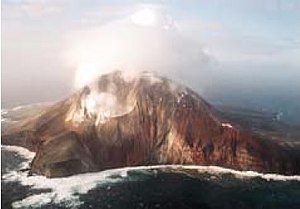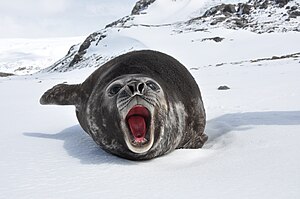South Georgia and the South Sandwich Islands (SGSSI) are a chain of Subantarctic islands in the Southern Ocean surrounding Antarctica. The islands are an overseas territory of the United Kingdom: they have no permanent residents and their administration is physically based in the Falklands, but since 1985 they have been a separate jurisdiction.
Islands
[edit]- 1 South Georgia Island is the only inhabited island, with the summer-only settlement of Grytviken, and the only one regularly visited by cruise ships. Minor islands are ranged along its north coast – those visited by cruises are Willis, Bird, Albatross and Prion, and Cooper. The south coast is exposed to raging winds and waves and is seldom visited – Annenkov is the only large island on that side.
- 2 Shag Rocks are six islets 240 km west of South Georgia, discovered by Jose de la Llana in 1762. They're just guano-streaked crags (pictured at head of page) rising to a maximum 75 m, and are indeed populated by shags, as well as prions and wandering albatrosses. There's no landing point and the first person to set foot there, in 1956, was an Argentinian geologist lowered by helicopter to collect rock samples.
- Black Rock is a low rock 16 km southeast of the Shag Rocks. It was only charted in 1927 though probably there were earlier sightings.
- 3 Clerke Rocks are a group 55 km off the southeast tip of South Georgia, some 8 km long. They're named for the officer who sighted them on Cook's expedition of 1775. They have no safe landing places and only four parties have ever got ashore. They rise to 242 m, notable outcrops being "The Office Boys" and "Nobby". Lots of cormorants here, plus Macaroni penguins, black-browed albatross and Antarctic fur seals.
- South Sandwich Islands are an extensive chain that are ice-clad and volcanic, in four groups:
- 8 South Orkney Islands are not part of SGSSI, but are marked on the map to show how the underwater mountain chain loops back to become the Antarctic Peninsula. They lie south of the 60th parallel and are covered by the Treaty: see Islands of the Southern Ocean.
- 1 Iceberg A23a is a colossal iceberg approaching SGSSI in 2024.
- 2 Aurora Islands are phantom islands. They were first sighted in 1762 midway between South Georgia and the Falkland Islands, and over the next century several other vessels sighted them at about 53°S 48°W – but there they most definitely are not. There's no satisfactory explanation for the sightings. Ships would have to be many hundreds of miles off course to encounter another substantial island group. Neither the Shag Rocks nor a colossal iceberg would resemble the wild coast described. The submerged Andean mountain chain winds through the region to South Georgia and the Antarctic peninsula; volcanic islands do sometimes disappear but there is no recent volcanism or traces of a recently submerged mountain in that position. And there was no particular kudos attached to seeing or not seeing them.
Understand
[edit]The American Cordillera is the line of mountain ranges that spans half the world, from Alaska through the Rockies to central America and the Andes. Until 30 million years ago this line continued east and south in the "Scotia Arc" from Tierra del Fuego through the Falklands, South Georgia, the South Sandwich and South Orkney Islands and the Antarctic Peninsula. Then the mountains sank, and by 23 million years ago the rift was complete. Antarctica became a separate continent, encircled by a circumpolar ocean current that kept out warmer winds and waters, and a climate that was already chilly became exceptionally cold. All that was left between Antarctica and the Andes was the loop of mountainous islands. These repeatedly submerged and rose again as plate tectonics distorted the region, while the eastern arc became volcanic, a frigid replica of the Caribbean chain.
The Antarctic Convergence is the zone where the very cold circumpolar current meets the milder sub-Antarctic ocean. It's about 40 km wide, fairly static, and defines a climatic boundary. This zone is well north of South Georgia, but south of the Falkland Islands, so the latter's climate is much less harsh though they're at similar latitude. The mixing and upwelling of water along the Convergence creates a food chain: it fosters the growth of plankton, which are eaten by krill, which are eaten by whales and other large species. These in turn became hunted by humans.
South Georgia and the other islands were discovered (or with the Aurora Islands, imagined) in the 18th and 19th centuries. They were uninhabited, with no mineral wealth, and their main value was as bases for ships hunting whales and seals. In this remote dangerous ocean, any cove was welcome if it had sheltered anchorage, dry level ground for camping, fresh water, and wildlife to eat. A cluster around Grytviken on South Georgia became year-round settlements, with others as summer camps. For similar reasons South Georgia was also a staging post for explorers heading to Antarctica – and famously for Ernest Shackleton, it was a forlorn-hope refuge on his way back.
Sea-faring nations made claims on these islands, as on the Antarctic mainland, in hopes of deep-sea oil or other lucre, and for the usual flag-waving reasons: "It's the frozen pits, but we're damned if we'll let the commies claim it". In Antarctica all these claims were waived in the Treaty, created in 1959 and coming into force in 1961, but it doesn't apply north of the 60th parallel. South Georgia and the South Sandwich Islands are north of that line, and are therefore held and governed by Britain. Argentina also claims them, and the 1982 Falklands or Malvinas War was triggered by Argentine landings on South Georgia. Forty years on, you need British permission to land, but that's chiefly to protect wildlife and the fragile habitat.
Get in
[edit]
| “ | The greatest part of this southern continent (supposing there is one), must lie within the polar circle, where the sea is so pestered with ice, that the land is thereby inaccessible. | ” |
—Captain James Cook, A Voyage Towards the South Pole and Round the World, etc" (1777) | ||
There are no landing strips and you can only get in by sea. The seas around South Georgia are cold and rough but free of pack ice year-round, so vessels can approach at any time of year. In summer that island is routinely visited by cruise ships, and there are multiple places where you can get ashore then get off again without risking your neck – see South Georgia Island#Get in for details.
The South Sandwich Islands are a much tougher proposition. They are beset by pack ice from April to October, though the density and extent vary year by year. This ice is a metre thick so icebreakers could still get through, unlike the massive ice shelf close to Antarctica. The island landing points are at best hazardous, and some would be daunting even to a stoked-up Marines Commando. You would need to have a special scientific purpose and bring a heavy-duty polar expedition.
You need a valid passport to visit SGSSI. You don't need a visa, but the expedition organiser or ship's captain must obtain clearance to land anywhere in these islands – this is done online more than 60 days in advance via the SGSSI government website[dead link]. The main considerations are bio-security (including Covid-19), self-sufficiency, and resilience if something goes wrong. Clearance results in a one year permit, and first-time applicants must initially land at Grytviken for a physical check-out – how rat-proof is your vessel? Veterans may conduct the entire process online and go straight to their destination. There's a fee of £130 per visitor for visits up to 3 days, but that's only a small part of the charges for harbourage, customs and so on, which the ship's operator will have to recoup from the passengers. Tourist parties only spend a few hours ashore at each location, then return to their ships between excursions. Staying ashore overnight makes it an expedition, which incurs a £1000 charge per group (of recommended size 4–15). But yes, you can get married here, that'll be another £400 please.
Cruise operators to SGSSI are members of IAATO and follow the same Code of Practice as for Antarctica. This limits the number of visitors who may be ashore at any one time, partly to limit the environment impact but mainly so that everyone can be swiftly plucked to safety when (not if) conditions turn dangerous. At Grytviken, which has a harbour, the maximum is 300, elsewhere in the islands it's 100. Large ships therefore have to segment their landings, with Zodiacs shuttling ship-to-shore, so those passengers might only get a couple of hours per day off ship. Smaller expedition-class ships can dock at Grytviken, and at other sites get their shore parties out and back in one operation then move on to visit a second location same day. Everything depends on the weather: an onshore breeze (which in these climes will be going on a gale) will send furious breakers pounding onto the landing beach.
Get around
[edit]
Moving any significant distance is by boat, even within the same island. Ships deploy Ribs / Zodiacs for short hops.
In summer by the coast you can walk around in stout boots. In winter the ground is snow-clad even at sea level so you need snow shoes or cross-country skis. Only competent mountaineers should venture inland, where glaciers shift and ice chasms lurk unseen beneath the snow. In South Georgia you might also have to factor in high altitude.
The bio-security protocols for arriving into SGSSI also apply to moving between sites, because they're a series of unique little bio-spheres that mustn't contaminate each other. So at the very least, boot-wash; anything that might trap soil needs particular care.
Talk
[edit]It's a British territory so English is spoken by everyone. A visiting ship might have its own working language.
See and do
[edit]
- As in Antarctica, even just standing there looking involves some effort, hazard and discomfort on your part, so in SGSSI seeing means doing. Likewise doing means always be looking, you never know what strange creature or phenomenon may come into view, that isn't on your planned itinerary. And always watch out for how the weather and the sea are changing, and how the rest of your party are faring. The most important thing for you to do here is come home safe.
- Grab trash before it blows away, if it's obviously modern, like a sweety-wrapper. Otherwise check with your leader, who'll know precisely how old and grungy it has to be to count as a protected artifact, Bellingshausen's bubble gum for instance.
- South Georgia Island sights are detailed on that page. Some half a dozen islets and coves are routinely visited for their wildlife, and there are old whaling stations at Grytviken and Stromness Bay.
- Zavodovski Island (Traversay): you'll earn bragging rights if you set foot here and return intact. About 5 km across, it's mostly unglaciated, with a million pairs of chinstrap penguins. That's because its peak, the well-named Mount Asphyxia (551 m), is an active strato-volcano which last erupted in 2016 and oozes sulphurous fumes.
- Visokoi Island (Traversay) is 7 km by 5 km and is smelly rather than choking – Mount Hodson (1005 m) last erupted in 1930, and continues to steam.
- Leskov Island (Traversay) is inactive, and the only thing to see here is to see you don't confuse it with Leskov Island off West Antarctica.
- Candlemas Island, 3 km by 2 km, has Lucifer Hill, with lava flows seen in 1953–1954. Nearby Vindication Island has been quiet for 10,000 years.
- Saunders Island (Central) is a crescent 9 km long. Mount Michael (805 m) has a lava lake and frequently erupts, with the latest in 2019.
- Montagu Island (Central) is 12 km by 10 km and ice-clad. Mount Belinda (1370 m) was thought to be inactive, but is now known to keep busy beneath the ice, with the latest lava flows in 2009.
- Bristol Island (Central), 8 km long, has multiple volcanoes, with the latest eruption in 2016. It's the only landmass to lie on the 59th parallel South – sure to come up in a pub quiz.
- Bellingshausen Island (Southern Thule) rises to Basilisk Peak at 255 m. A cliff plunges from the peak into a steaming crater, probably formed by an explosion in the 1970s.
- Cook Island (Southern Thule), 6 km by 3 km, is ice-clad. Mount Harmer (1115 m) is inactive but Mount Holdgate (960 m) erupted in 1956, to the dismay of an Argentine base.
- Thule Island (aka Morrell, Southern Thule) is the Santorini of the south: the terrain suggests that it was joined to Cook Island by a giant volcano that blew apart, leaving these two fragments and a crater as the 3 km channel between. The peak is at 1074 m; Mount Larsen (710 m) emitted steam and ash in the 1960s but has no recorded eruptions. As Thule lies at 59.45° S, it's 60 km north of the Antarctic Treaty boundary beyond which territorial claims are waived. In 1976 Argentina sought to revive its regional claims (preferably on a non-erupting spot) and established Corbeta Uruguay base on the southeast tip of Thule. The British objected but were content with a languid diplomatic badminton until 1982, when the base was used as a staging post for Argentine forces landing in South Georgia. This sparked the Falklands War: after Britain regained the Falklands they ousted the Argentines from the base but left it intact. Some months later, a Royal Navy patrol spotted the Argentine flag fluttering in place of the Union Flag – right! So they demolished the base to discourage unauthorised landings.
Buy
[edit]There is a small gift shop at Grytviken which will accept Falkland pounds, British pounds, US dollars and euros. Water is sold by the tonne. Most large ships visiting the islands will sell basic supplies (razors, shampoo, hats, snacks), but otherwise it is unlikely you will have any use for cash.
Eat
[edit]
You may not hunt, fish or eat the wildlife. Don't feed it either, though there's an exemption for upchucking as your Zodiac pitches in the swell: the fish and seabirds will appreciate this contribution.
You may not bring fresh food ashore anywhere in SGSSI, unless you're a registered expedition. Chocolates and toffees are okay for tour parties.
So that alas rules out eating sandwiches in the Sandwich Islands. Both foodstuff and islands commemorate John Montagu, 4th Earl of Sandwich (1718–1792), who was First Lord of the Admiralty at the time of Cook's 1775 voyage here. Meat or cheese between bread slices was already common in England but the Earl made them aristocratically fashionable – supposedly he called for a snack while playing cribbage in around 1765, and his companions then asked for "the same as Sandwich." (He probably already ate them al desko, being a busy fellow, which didn't stop in the bedroom.) But Cook, knowing which side his bread was buttered in patronage, also conferred the name on the Hawaiian Islands. So these cold places were later distinguished as the South Sandwich Islands, while Hawaii somehow escaped being called the "Not the same as Sandwich Islands".
Drink
[edit]- On short excursions, bring all drinks with you. Don't drink alcohol until you're safely back on your ship, with the exception of raising a toast at Shackleton's grave at Grytviken.
- Don't drink from the meltwater pools, they're full of bird poop and other unspeakables. Expeditions can cut clean ice to melt for water.
Sleep
[edit]Visitors sleep back aboard their ship. An overnight stay ashore anywhere in SGSSI makes it an expedition, which must be vetted well in advance, for a £1000 fee.
Stay safe
[edit]See the stay safe section of the next-to-impossible destinations article for general information on staying safe in remote locations.
Stay healthy
[edit]- Beware of the sun, particularly during the September to November ozone hole season. Protect yourself with high protection factor cream (30+), a floppy hat and long sleeves. If going onto glaciers or snow this is vital, as are good sunglasses.
- Fur seal bites rapidly become infected. If you get bitten, even just a scratch, you must clean the wound and start antibiotics immediately – a broad spectrum such oxytetracycline is advised.
- Drink plenty of water and avoid dehydration, particularly if it is windy.
Respect
[edit]
- Respect wildlife. It lives here, we don't. Breeding animals in particular are prone to disturbance. Your tour leader will indicate where to go and where not to stray: transgressors may be busted off shore visits.
- "Don't mention the war!" – it's almost 40 years since the overthrow of the junta that instigated the Falklands War, which embroiled SGSSI. Argentina has not renounced its claims to these islands but any activity here nowadays, as in Antarctica, is in a spirit of scientific enquiry.
Connect
[edit]In summer mail can be posted in Grytviken, and it's picked up whenever either a supply ship or a fishery patrol ship arrives – usually around once a month. The only other option for contacting the outside world is with a satellite phone, which most boats will make available at a charge of between US$2 and US$5 per minute.
There is no public Internet, phone or email access available on shore.
Go next
[edit]- Your cruise ship may head west to the Falkland Islands and a South American mainland port.
- Or it may continue south towards the Antarctic Peninsula and the South Shetland Islands.
- If the ship follows the chain of volcanic islands before heading to the Peninsula, it will pass South Orkney, rarely visited.



